Gang Hua
Wormpex AI Research
ATLAS: Actor-Critic Task-Completion with Look-ahead Action Simulation
Oct 26, 2025Abstract:We observe that current state-of-the-art web-agents are unable to effectively adapt to new environments without neural network fine-tuning, without which they produce inefficient execution plans due to a lack of awareness of the structure and dynamics of the new environment. To address this limitation, we introduce ATLAS (Actor-Critic Task-completion with Look-ahead Action Simulation), a memory-augmented agent that is able to make plans grounded in a model of the environment by simulating the consequences of those actions in cognitive space. Our agent starts by building a "cognitive map" by performing a lightweight curiosity driven exploration of the environment. The planner proposes candidate actions; the simulator predicts their consequences in cognitive space; a critic analyzes the options to select the best roll-out and update the original plan; and a browser executor performs the chosen action. On the WebArena-Lite Benchmark, we achieve a 63% success rate compared to 53.9% success rate for the previously published state-of-the-art. Unlike previous systems, our modular architecture requires no website-specific LLM fine-tuning. Ablations show sizable drops without the world-model, hierarchical planner, and look-ahead-based replanner confirming their complementary roles within the design of our system
Hacking Hallucinations of MLLMs with Causal Sufficiency and Necessity
Aug 06, 2025



Abstract:Multimodal Large Language Models (MLLMs) have demonstrated impressive capabilities across vision-language tasks. However, they may suffer from hallucinations--generating outputs that are semantically inconsistent with the input image or text. Through causal analyses, we find that: (i) hallucinations with omission may arise from the failure to adequately capture essential causal factors, and (ii) hallucinations with fabrication are likely caused by the model being misled by non-causal cues. To address these challenges, we propose a novel reinforcement learning framework guided by causal completeness, which jointly considers both causal sufficiency and causal necessity of tokens. Specifically, we evaluate each token's standalone contribution and counterfactual indispensability to define a token-level causal completeness reward. This reward is used to construct a causally informed advantage function within the GRPO optimization framework, encouraging the model to focus on tokens that are both causally sufficient and necessary for accurate generation. Experimental results across various benchmark datasets and tasks demonstrate the effectiveness of our approach, which effectively mitigates hallucinations in MLLMs.
Reward Model Generalization for Compute-Aware Test-Time Reasoning
May 23, 2025Abstract:External test-time reasoning enhances large language models (LLMs) by decoupling generation and selection. At inference time, the model generates multiple reasoning paths, and an auxiliary process reward model (PRM) is used to score and select the best one. A central challenge in this setting is test-time compute optimality (TCO), i.e., how to maximize answer accuracy under a fixed inference budget. In this work, we establish a theoretical framework to analyze how the generalization error of the PRM affects compute efficiency and reasoning performance. Leveraging PAC-Bayes theory, we derive generalization bounds and show that a lower generalization error of PRM leads to fewer samples required to find correct answers. Motivated by this analysis, we propose Compute-Aware Tree Search (CATS), an actor-critic framework that dynamically controls search behavior. The actor outputs sampling hyperparameters based on reward distributions and sparsity statistics, while the critic estimates their utility to guide budget allocation. Experiments on the MATH and AIME benchmarks with various LLMs and PRMs demonstrate that CATS consistently outperforms other external TTS methods, validating our theoretical predictions.
Componential Prompt-Knowledge Alignment for Domain Incremental Learning
May 07, 2025Abstract:Domain Incremental Learning (DIL) aims to learn from non-stationary data streams across domains while retaining and utilizing past knowledge. Although prompt-based methods effectively store multi-domain knowledge in prompt parameters and obtain advanced performance through cross-domain prompt fusion, we reveal an intrinsic limitation: component-wise misalignment between domain-specific prompts leads to conflicting knowledge integration and degraded predictions. This arises from the random positioning of knowledge components within prompts, where irrelevant component fusion introduces interference.To address this, we propose Componential Prompt-Knowledge Alignment (KA-Prompt), a novel prompt-based DIL method that introduces component-aware prompt-knowledge alignment during training, significantly improving both the learning and inference capacity of the model. KA-Prompt operates in two phases: (1) Initial Componential Structure Configuring, where a set of old prompts containing knowledge relevant to the new domain are mined via greedy search, which is then exploited to initialize new prompts to achieve reusable knowledge transfer and establish intrinsic alignment between new and old prompts. (2) Online Alignment Preservation, which dynamically identifies the target old prompts and applies adaptive componential consistency constraints as new prompts evolve. Extensive experiments on DIL benchmarks demonstrate the effectiveness of our KA-Prompt. Our source code is available at https://github.com/zhoujiahuan1991/ICML2025-KA-Prompt
Token Coordinated Prompt Attention is Needed for Visual Prompting
May 05, 2025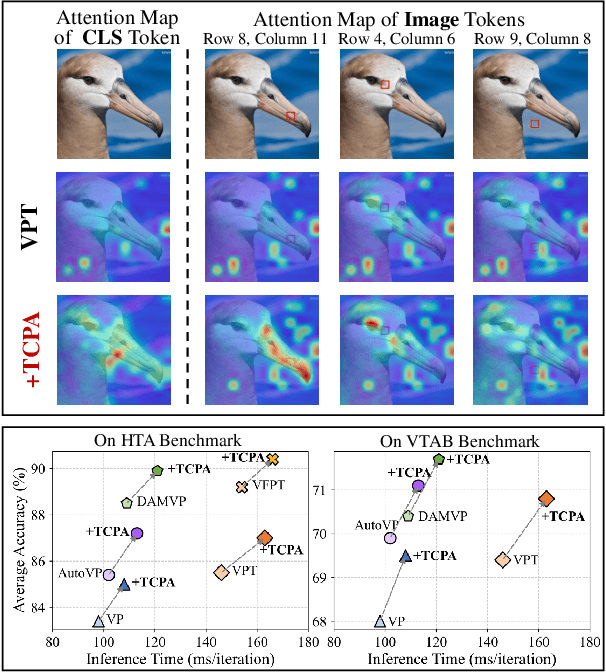
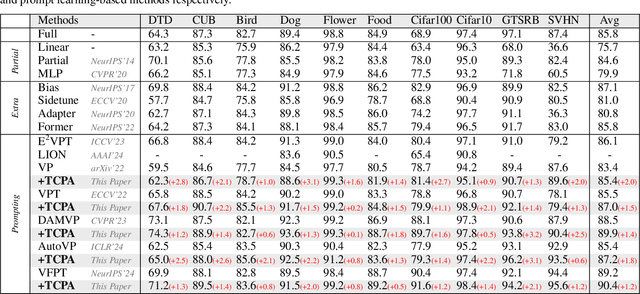
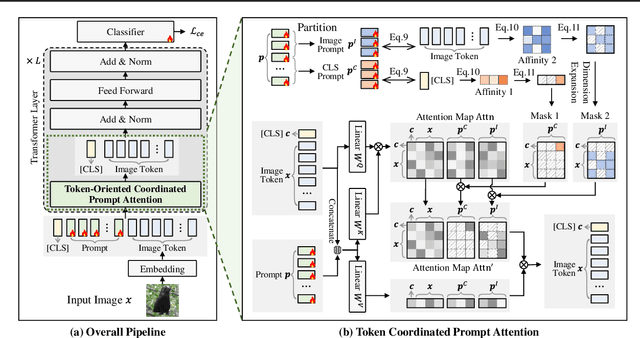
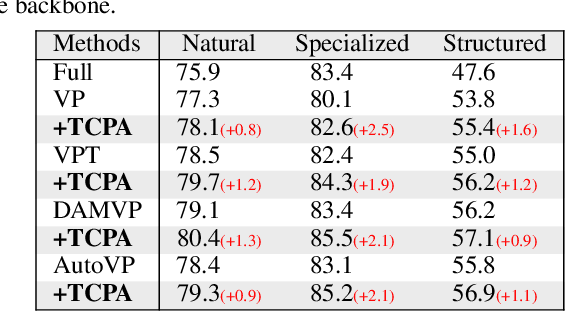
Abstract:Visual prompting techniques are widely used to efficiently fine-tune pretrained Vision Transformers (ViT) by learning a small set of shared prompts for all tokens. However, existing methods overlook the unique roles of different tokens in conveying discriminative information and interact with all tokens using the same prompts, thereby limiting the representational capacity of ViT. This often leads to indistinguishable and biased prompt-extracted features, hindering performance. To address this issue, we propose a plug-and-play Token Coordinated Prompt Attention (TCPA) module, which assigns specific coordinated prompts to different tokens for attention-based interactions. Firstly, recognizing the distinct functions of CLS and image tokens-global information aggregation and local feature extraction, we disentangle the prompts into CLS Prompts and Image Prompts, which interact exclusively with CLS tokens and image tokens through attention mechanisms. This enhances their respective discriminative abilities. Furthermore, as different image tokens correspond to distinct image patches and contain diverse information, we employ a matching function to automatically assign coordinated prompts to individual tokens. This enables more precise attention interactions, improving the diversity and representational capacity of the extracted features. Extensive experiments across various benchmarks demonstrate that TCPA significantly enhances the diversity and discriminative power of the extracted features. The code is available at https://github.com/zhoujiahuan1991/ICML2025-TCPA.
RSRNav: Reasoning Spatial Relationship for Image-Goal Navigation
Apr 25, 2025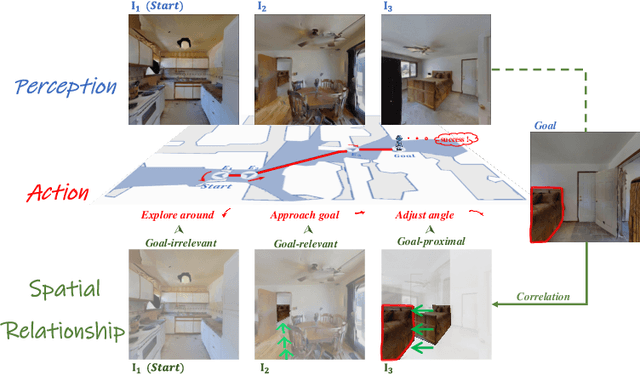
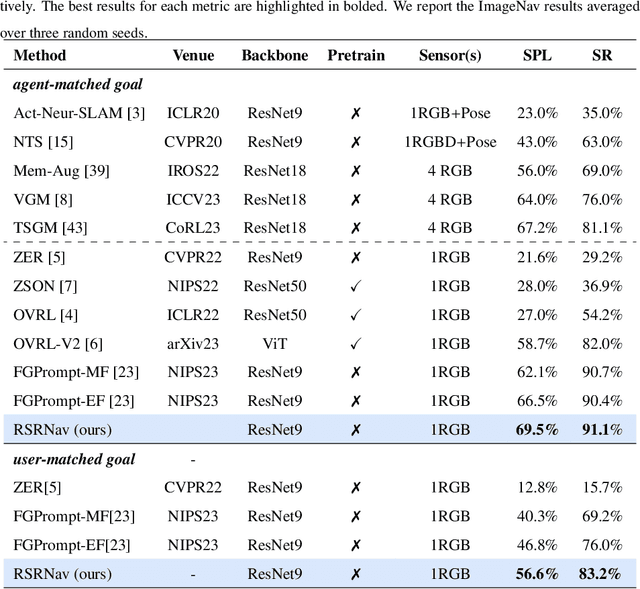
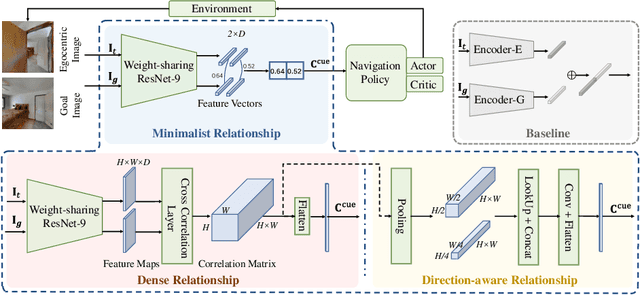
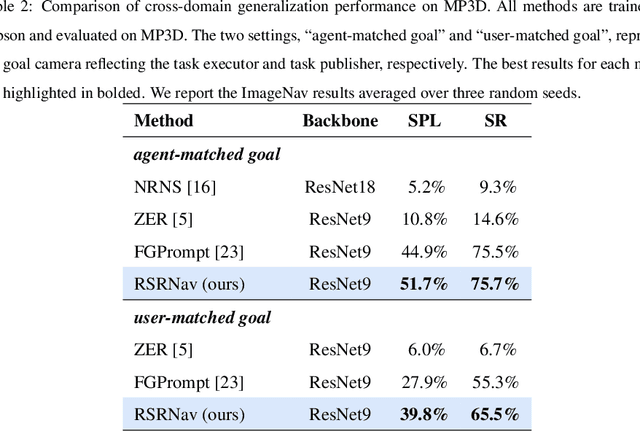
Abstract:Recent image-goal navigation (ImageNav) methods learn a perception-action policy by separately capturing semantic features of the goal and egocentric images, then passing them to a policy network. However, challenges remain: (1) Semantic features often fail to provide accurate directional information, leading to superfluous actions, and (2) performance drops significantly when viewpoint inconsistencies arise between training and application. To address these challenges, we propose RSRNav, a simple yet effective method that reasons spatial relationships between the goal and current observations as navigation guidance. Specifically, we model the spatial relationship by constructing correlations between the goal and current observations, which are then passed to the policy network for action prediction. These correlations are progressively refined using fine-grained cross-correlation and direction-aware correlation for more precise navigation. Extensive evaluation of RSRNav on three benchmark datasets demonstrates superior navigation performance, particularly in the "user-matched goal" setting, highlighting its potential for real-world applications.
Moment Quantization for Video Temporal Grounding
Apr 03, 2025
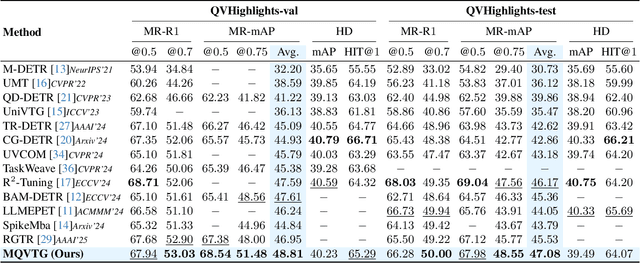


Abstract:Video temporal grounding is a critical video understanding task, which aims to localize moments relevant to a language description. The challenge of this task lies in distinguishing relevant and irrelevant moments. Previous methods focused on learning continuous features exhibit weak differentiation between foreground and background features. In this paper, we propose a novel Moment-Quantization based Video Temporal Grounding method (MQVTG), which quantizes the input video into various discrete vectors to enhance the discrimination between relevant and irrelevant moments. Specifically, MQVTG maintains a learnable moment codebook, where each video moment matches a codeword. Considering the visual diversity, i.e., various visual expressions for the same moment, MQVTG treats moment-codeword matching as a clustering process without using discrete vectors, avoiding the loss of useful information from direct hard quantization. Additionally, we employ effective prior-initialization and joint-projection strategies to enhance the maintained moment codebook. With its simple implementation, the proposed method can be integrated into existing temporal grounding models as a plug-and-play component. Extensive experiments on six popular benchmarks demonstrate the effectiveness and generalizability of MQVTG, significantly outperforming state-of-the-art methods. Further qualitative analysis shows that our method effectively groups relevant features and separates irrelevant ones, aligning with our goal of enhancing discrimination.
Glissando-Net: Deep sinGLe vIew category level poSe eStimation ANd 3D recOnstruction
Jan 24, 2025



Abstract:We present a deep learning model, dubbed Glissando-Net, to simultaneously estimate the pose and reconstruct the 3D shape of objects at the category level from a single RGB image. Previous works predominantly focused on either estimating poses(often at the instance level), or reconstructing shapes, but not both. Glissando-Net is composed of two auto-encoders that are jointly trained, one for RGB images and the other for point clouds. We embrace two key design choices in Glissando-Net to achieve a more accurate prediction of the 3D shape and pose of the object given a single RGB image as input. First, we augment the feature maps of the point cloud encoder and decoder with transformed feature maps from the image decoder, enabling effective 2D-3D interaction in both training and prediction. Second, we predict both the 3D shape and pose of the object in the decoder stage. This way, we better utilize the information in the 3D point clouds presented only in the training stage to train the network for more accurate prediction. We jointly train the two encoder-decoders for RGB and point cloud data to learn how to pass latent features to the point cloud decoder during inference. In testing, the encoder of the 3D point cloud is discarded. The design of Glissando-Net is inspired by codeSLAM. Unlike codeSLAM, which targets 3D reconstruction of scenes, we focus on pose estimation and shape reconstruction of objects, and directly predict the object pose and a pose invariant 3D reconstruction without the need of the code optimization step. Extensive experiments, involving both ablation studies and comparison with competing methods, demonstrate the efficacy of our proposed method, and compare favorably with the state-of-the-art.
Neuromodulated Meta-Learning
Nov 11, 2024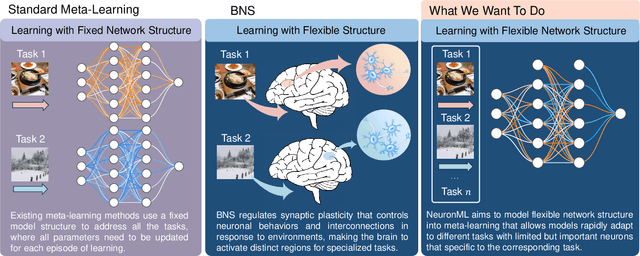
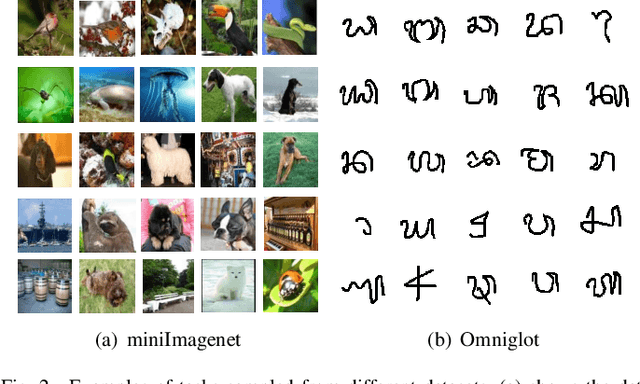
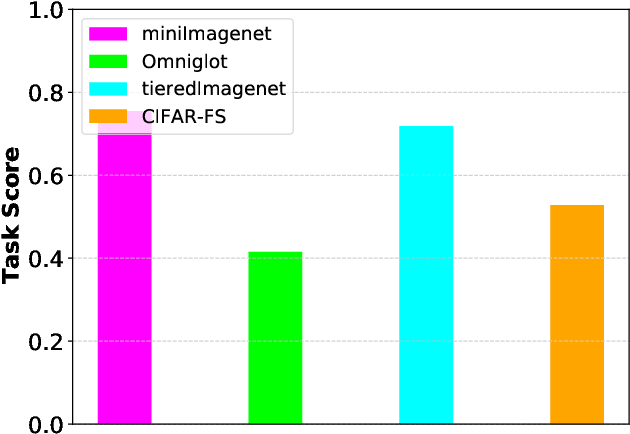

Abstract:Humans excel at adapting perceptions and actions to diverse environments, enabling efficient interaction with the external world. This adaptive capability relies on the biological nervous system (BNS), which activates different brain regions for distinct tasks. Meta-learning similarly trains machines to handle multiple tasks but relies on a fixed network structure, not as flexible as BNS. To investigate the role of flexible network structure (FNS) in meta-learning, we conduct extensive empirical and theoretical analyses, finding that model performance is tied to structure, with no universally optimal pattern across tasks. This reveals the crucial role of FNS in meta-learning, ensuring meta-learning to generate the optimal structure for each task, thereby maximizing the performance and learning efficiency of meta-learning. Motivated by this insight, we propose to define, measure, and model FNS in meta-learning. First, we define that an effective FNS should possess frugality, plasticity, and sensitivity. Then, to quantify FNS in practice, we present three measurements for these properties, collectively forming the \emph{structure constraint} with theoretical supports. Building on this, we finally propose Neuromodulated Meta-Learning (NeuronML) to model FNS in meta-learning. It utilizes bi-level optimization to update both weights and structure with the structure constraint. Extensive theoretical and empirical evaluations demonstrate the effectiveness of NeuronML on various tasks. Code is publicly available at \href{https://github.com/WangJingyao07/NeuronML}{https://github.com/WangJingyao07/NeuronML}.
Scale Propagation Network for Generalizable Depth Completion
Oct 24, 2024



Abstract:Depth completion, inferring dense depth maps from sparse measurements, is crucial for robust 3D perception. Although deep learning based methods have made tremendous progress in this problem, these models cannot generalize well across different scenes that are unobserved in training, posing a fundamental limitation that yet to be overcome. A careful analysis of existing deep neural network architectures for depth completion, which are largely borrowing from successful backbones for image analysis tasks, reveals that a key design bottleneck actually resides in the conventional normalization layers. These normalization layers are designed, on one hand, to make training more stable, on the other hand, to build more visual invariance across scene scales. However, in depth completion, the scale is actually what we want to robustly estimate in order to better generalize to unseen scenes. To mitigate, we propose a novel scale propagation normalization (SP-Norm) method to propagate scales from input to output, and simultaneously preserve the normalization operator for easy convergence. More specifically, we rescale the input using learned features of a single-layer perceptron from the normalized input, rather than directly normalizing the input as conventional normalization layers. We then develop a new network architecture based on SP-Norm and the ConvNeXt V2 backbone. We explore the composition of various basic blocks and architectures to achieve superior performance and efficient inference for generalizable depth completion. Extensive experiments are conducted on six unseen datasets with various types of sparse depth maps, i.e., randomly sampled 0.1\%/1\%/10\% valid pixels, 4/8/16/32/64-line LiDAR points, and holes from Structured-Light. Our model consistently achieves the best accuracy with faster speed and lower memory when compared to state-of-the-art methods.
 Add to Chrome
Add to Chrome Add to Firefox
Add to Firefox Add to Edge
Add to Edge